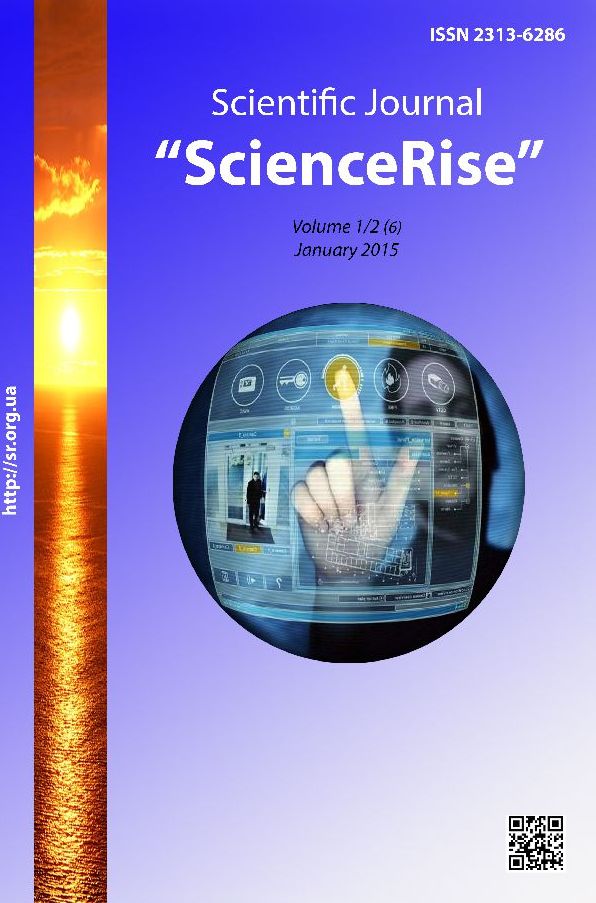Remowal of water from low-polarity liquids by solid adsorbents
DOI:
https://doi.org/10.15587/2313-8416.2015.36155Keywords:
fuel, ethanol, hydrolysis, temperature, dehydration, engine, combustion heat, organic liquids, delamination, gasolineAbstract
The use of alternative oxygenate fuels instead of gasoline fuel can produce a number of benefits for the engine, but it also prevents a number of disadvantages. The methods for removal of these disadvantages are developed. It is known that the oxygenate fuels are products of hydrolysis of plant production, and can therefore be used as an alternative fuel. The features of dehydration low-polarity liquids are considered
References
Lichtblau, J. et. al. (2004). MTBE issues include questions of all oxygenates mandates. Oil and Gas, 22, 18–24.
Onoichenko, S. A. (2003). Primeneniye oksigenatov pri proizvodstve perspektivnux avtomobilnux benzinov.Moscow, Techtika, 64.
Kempen, V. X. (2002). Ispolzovaniye spirtov v kazhestve topliva dlya dvigateley vnutrennego zhoraniya. Neft`, gaz i neftechimiya za rubezhom, 34.
Putilov, A. V. (2005). Sovremennoye sostiyanie i perspektivu ispol`zovaniya spirtovyx motorlyx topliv`. Otchet po NIR. Moscow, Computer Model Center, 56–59.
Lapidus, A. L, Kryliv, I. F, Zagfarov, F. G, Emel`yanov, V. T (2008). Al`ternativnyie motorniye topliva. Uchebnoye posobiye. Russian State Oil andGasUniversitynamed by Gubkin. ZentrLitNefreGas, 84–88.
Barannik, V. P., Emel`yanov, V. E., Makarov, V. V., Onoichenko, S. I., Petrukin, A. A., Shamonina, A. V. (2005). Etilovui spirt v motornom toplive. Pod` redakziyei doktora nauk V. V. Makarova.Moscow, 92.
Braunstein, B. A., Klimenko, V. L., Zerkin, E. B. (2004). Proizvodstvo spirtov iz neftyanogo i gazovogo sur`ya. Nedra, Saint-Petersburg, 136.
Lidin, R. A., Molotshko, V. A., Andreeva, L. L. (2000). Spravochnik po neorganicheskoy chimii, konstanty neorganicheskyx veshestv.Moscow, Chemistry, 480.
Kulikov, A. B. (2004). Sintez i svoystva gidroksosulphatov` medi, medi-nickelya i medi-kobalta. Peoples' FriendshipUniversityofRussia,Moscow, 14.
Proskurina, O. V. (2001). Issledovaniye otkrytyx phasovux prozessov v chetyrioxkomponentnoy` vodno-solevoy sisteme, sodershashey sulphaty magniya, nichelya i zunka pri25 °C. St. Petersburg, Saint Petersburg State Institute of Technology, 6.
Downloads
Published
Issue
Section
License
Copyright (c) 2015 Николай Андреевич Блинков, Анатолий Николаевич Бутенко, Игорь Михайлович Рыщенко

This work is licensed under a Creative Commons Attribution 4.0 International License.
Our journal abides by the Creative Commons CC BY copyright rights and permissions for open access journals.
Authors, who are published in this journal, agree to the following conditions:
1. The authors reserve the right to authorship of the work and pass the first publication right of this work to the journal under the terms of a Creative Commons CC BY, which allows others to freely distribute the published research with the obligatory reference to the authors of the original work and the first publication of the work in this journal.
2. The authors have the right to conclude separate supplement agreements that relate to non-exclusive work distribution in the form in which it has been published by the journal (for example, to upload the work to the online storage of the journal or publish it as part of a monograph), provided that the reference to the first publication of the work in this journal is included.

